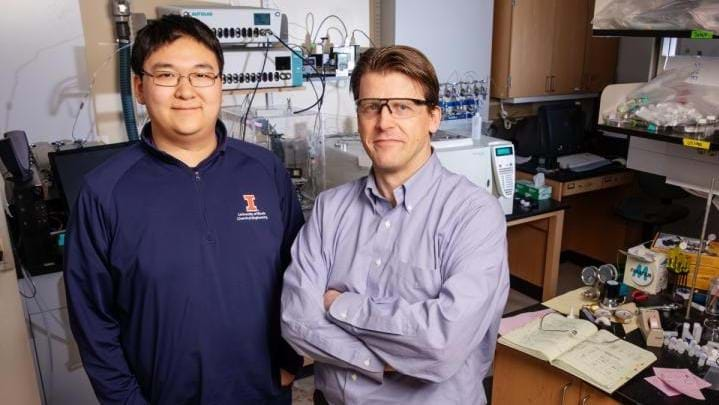Reducing the energy required to produce greener chemicals

PRODUCING useful chemicals from carbon dioxide via electrolysis typically has a high energy consumption, but a new process has halved the energy required by using glycerol.
Carbon chemicals are traditionally made using fossil fuel processes, for example ethylene is produced from steam cracking, and carbon monoxide from coal gasification or steam reforming. Excess CO2 can be used as a feedstock to produce these chemicals via electrolysis, which provides an alternative approach to methods that are otherwise difficult to decarbonise.
Typical CO2 electroreduction processes couple cathodic CO2 reduction with anodic oxygen evolution reaction (OER). However, the OER uses around 90% of the energy input. Lowering the electricity consumption, and therefore the cell potential, is essential to improve the efficiency of CO2 electroreduction and therefore make it possible to use grid electricity. Chemical engineers at the University of Illinois, US, have found a way to reduce the energy consumption of the process by 53% by using glycerol at the anode.
"About 90% of the energy required in conventional CO2 reduction is used up by the oxygen-producing, anode side of an electrolysis cell," said Paul Kenis, Chemical and Biomolecular Engineering Professor, Department Chair and study co-author. "But there is no big market for the excess oxygen, so 90% of the energy is essentially wasted."
"Looking beyond oxygen evolution at the anode seems like a win-win situation, as we not only reduce the processes' energy consumption but also produce a second valuable product stream," said Sumit Verma, a former chemical and biomolecular engineering graduate student and study co-author. This could help co-electrolyse CO2 and waste glycerol from biodiesel production into CO and value-added chemicals such as formic acid.
Glycerol is a cheap byproduct of biodiesel and soap production that requires less energy to oxidise. The anodic oxidation of glycerol coupled to the cathodic reduction of CO2 lowers the cell potential and reduces the electricity consumption by up to 53%.
This energy reduction makes it possible to use the current electricity grid. "Our model uses the current electrical grid setup as the source of electricity to make the scenario more realistic," said Kenis. "Being able to drive CO2 conversion with already-in-place infrastructure – and not relying on the hope of the future grid being powered by 100% renewables – while achieving carbon neutrality or negativity could be a holy grail scenario."
Future work could involve integrating the process with biodiesel production. The process could also be improved by development of more active catalysts. The current production levels of glycerol aren’t sufficient to meet demand, so other avenues will need to be explored.
"The glycerol-based electrolysis reaction shows a lot of promise. However, we will continue to explore other organic waste materials because even when production rises in the wake of increased biofuel production, it still will not be enough to fully support the need," said Kenis. "The good news is that the chemistry involved is flexible and there are a lot of organic waste products that can do the job." Other future work could include investigating the co-electrolysis of CO2 and methane, which would be easier to scale up compared to glycerol.
Nature Energy http://doi.org/c535
Recent Editions
Catch up on the latest news, views and jobs from The Chemical Engineer. Below are the four latest issues. View a wider selection of the archive from within the Magazine section of this site.




